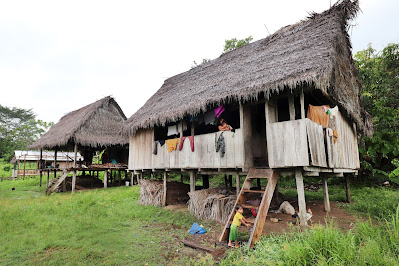The cries, hoots and shrills of colourful birds
ring out from the towering trees, along with the buzzing of insects I cannot
see. The air is hot and humid, causing a river of sweat to run down my neck,
but I don’t care.
I am here to experience a world completely different than my own and can’t help but feel nervous since a snake could be slithering under the leaves blanketing the path or lurking on a tree branch above my head. That nervousness turns into excitement when my guide suddenly spots a tiny pygmy marmoset monkey sitting nervously on a tree branch. Its big brown eyes dart back and forth like a pinball.
“They are very fast. It’s a big challenge
to see this monkey,” says my guide Hulber Paredes, noting many species in the
jungle are difficult to see because they are so well camouflaged. “The only way
to stay alive in the jungle and keep the legacy of a species is to hide.”
Seeing the smallest monkey in the world,
along with other exotic wildlife, is what prompted my father and I to join the
G Adventures Amazon Riverboat Adventure in Depth tour, which spends six days exploring
the rich culture and wildlife in Pacaya Samiria National Reserve.
The last time I shared a big adventure with my father was 10 years ago when we went to Uganda, Kenya and Rwanda to search for wild mountain gorillas. It was time for one more father-daughter adventure in the jungle.
Now here we were, whizzing down the Amazon
River on a motorized skiff to explore one of the many tributaries in Pacaya
Samiria National Reserve, which is one of the largest protected areas in Peru,
covering more than two million hectares.
Located 180 km southwest of the isolated city
of Iquitos, the reserve is home to diverse plants and animals that include
black jaguars, pink river dolphins, anacondas, monkeys, sloths and paiche – one
of the world’s largest freshwater fish that can grow up to 15 feet long. Most
of the forest in the reserve floods for five to six months during the rainy
season.
According to Paredes, the area is also home to approximately 400 Indigenous communities that often speak their own languages. The people have inhabited the region for hundreds of years using fishing, gathering, hunting and subsistence agriculture to survive.
“We have a big respect for everything here.
I enjoy every single second as soon as I step into the jungle,” said Paredes,
who grew up in an isolated village of about 50 people along the Napo River.
His family of 12 lived in a wooden home on
stilts with their chickens and piglets below. During the rainy season, it
wasn’t unusual to wake up and find an anaconda hanging from the rafters. Playing
volleyball, soccer or swimming in the river is how he passed the time.
“It was a simple life,” added Parades, who
left the village on his own at the age of 11 to pursue an education in Iquitos.
“It was a dream to just see how people look outside my village. I wanted to see
how they speak, how they dress. My teacher always said the best way to see the
outside world is to study so that was my ambition.”
The veins of rivers and tributaries are the roads of the Amazon, connecting sleepy villages that often consist of a few wooden homes on stilts and a one-room school. Small boats carrying people and supplies chug up and down the brown rivers teaming with egrets, kingfishers and black-collared hawks searching for prey. This is nature at its finest, and a world that becomes more fascinating every time I visit another community.
In the village of San Regis, Carola Pizango leads a normal life raising three
children with her husband. She’s also a well-known shaman that takes care of
nine communities sprinkled along the Maranon River. Some communities are four
to five hours from a doctor or a hospital.
When she was 14 years old, Pizango’s
grandfather, who was also a shaman, chose her and two apprentices to pass on
his knowledge. But first they had to follow a strict diet in the jungle for
eight years, only eating fish, bananas and water to purify their spirituality. Pizango
was the only one that graduated to become a shaman. She now has two apprentices
of her own.
“I can cure or make a treatment in any place,” said Pizango, who uses leaves, flowers, saps, barks, roots, vines and animal fat as natural medicine. “My healer house is very unique because it’s deep in the jungle and that energy makes me strong.”
My father and the 24 other travellers
staying on the Amatista riverboat don’t venture deep into the jungle, but puttering
along tributaries on motorized skiffs, slowly walking through small areas of
the jungle and visiting local villages provides a glimpse into life along the Amazon.
It’s a peaceful world refreshingly absent
from smart phones and electronic gadgets that consume much of our time. Sharing
this world with my father makes the experience even more special.
“I just love this,” says my father, as he
snaps photos of a ringed king fisher perched on a tree branch. “It’s natural
and peaceful. I feel myself starting to relax.”
If you go:
The G Adventures Amazon Riverboat Adventure
includes a six-night stay on the Amatista – a wooden vessel that sleeps 28
people in 14 cabins. The trip includes daily excursions
by motorized skiff to search for wildlife along riverbanks, guided walks
through the jungle, and visits to local communities. For more information
visit https://www.gadventures.com/trips/amazon-riverboat-adventure-in-depth/3372/
- published in the Vancouver Sun in February 2025: https://o.canada.com/travel/riverboat-adventure-through-peruvian-amazon-g-adventures
WATCH: Six days on a riverboat in the Amazon Rainforest






